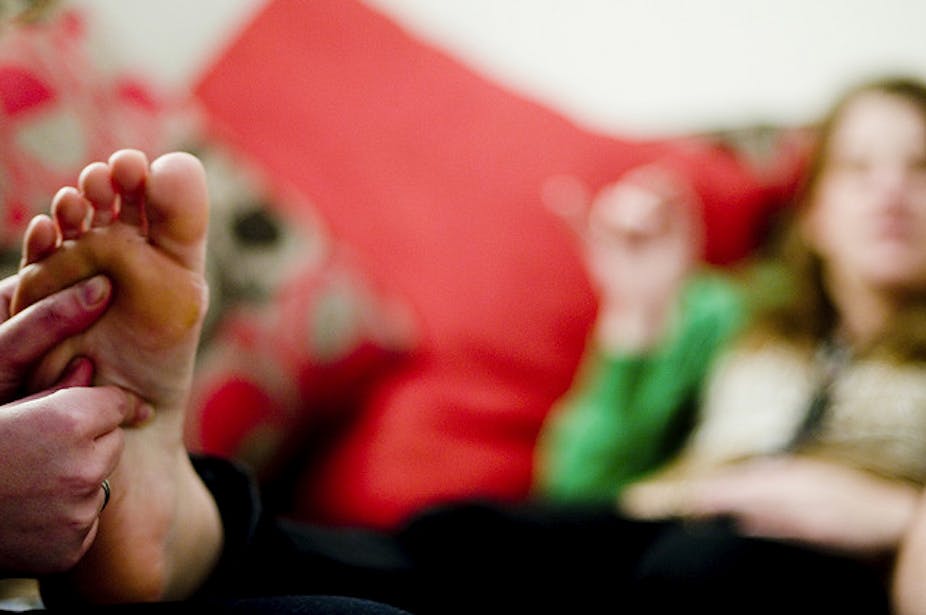Reflexology is a form of manual therapy based on the principle that specific locations on the feet, hands and ears have connections to the rest of the body. By applying pressure to these locations using various massage techniques, reflexology is thought to stimulate the body’s natural healing processes.
A very broad range of conditions are treated with reflexology, including headache, asthma, premenstrual syndrome, irritable bowel syndrome, dementia, incontinence, diabetes, low back pain and cancer-related pain. The Reflexology Association of Australia states that “all body systems benefit from reflexology”.
A population-based survey of 1,067 Australians in 2005 found that 4% had received reflexology in the previous 12 months.
History
The history of reflexology has not been thoroughly documented, although practises resembling reflexology have been identified from ancient Egyptian, Greek, Chinese, Indian and Native American sources.
A wall painting in the tomb of Ankhmahor (c 2,330BC) in Saqqara, Egypt is often cited as one of the earliest depictions of reflexology, although it is unclear whether the image merely represents massage as opposed to reflexology.

An early form of reflexology (zone therapy) was introduced to the United States in 1913 by Dr William Fitzgerald, an ear, nose and throat specialist. Fitzgerald proposed that there were ten vertical zones in the body. By stimulating the appropriate locations on the soles of the feet, bioelectrical energy flows could be altered, leading to pain relief in other body regions.
The modern practice of reflexology is primarily influenced by the work of Eunice Ingham, a nurse and physiotherapist whose 1938 text Stories the Feet Can Tell contained detailed maps of the “reflex” areas of the sole of the foot corresponding to the rest of the body, including internal organs.
Reflex areas do not correspond to either the nervous system or to acupuncture meridians, and published maps demonstrate several inconsistencies.

Mechanism
There is no clear consensus among reflexologists as to how the therapy “works”. Several mechanisms have been proposed, including the unblocking of energy fields, the removal of toxins, the breakdown of crystalline deposits in the lymphatic system, the release of endorphins, alteration of electromagnetic fields, and the increase of blood flow to internal organs.
Many of these mechanisms are inconsistent with mainstream physiological principles and are therefore unmeasurable with conventional scientific methods.
Four trials have demonstrated some evidence of a reduction in systolic blood pressure and heart rate in individuals undergoing reflexology. However, these studies did not adequately control for non-specific (placebo) effects, so it is not possible to delineate the benefit of stimulating reflex areas from the beneficial effects of simply lying down and receiving a relaxing foot massage.
Reflexology to aid diagnosis
Some reflexologists claim that the identification of tenderness at specific locations on the foot can assist in the diagnosis of medical conditions. Two studies have explored this by asking reflexologists to examine patients of whom they had no previous knowledge.
In both studies, the level of agreement between reflexologists was very low, as was the level of agreement between the reflexologists’ diagnoses and the known medical history of the patients. There was also evidence of over-diagnosis by the reflexologists. Therefore, the reflexology approach to diagnosis cannot be considered valid.
Does reflexology work?
The most recent and comprehensive systematic review on the effectiveness of reflexology found 23 trials where reflexology had been compared to no treatment, usual care, or a placebo/sham treatment. The methodological quality of these trials was generally poor, with few studies adequately controlling for non-specific (placebo) effects or blinding the assessors documenting the outcome measurements.

The review concluded that there is insufficient evidence to demonstrate that reflexology is an effective treatment for any medical condition.
It needs to be acknowledged, however, that conducting high quality trials of reflexology is inherently difficult. Possible solutions to the problems of inconsistent reflexology maps and difficulties controlling for placebo effects have recently been proposed, but have not yet been implemented.
Is reflexology safe?
There appears to be very few adverse effects associated with reflexology treatment itself. However, reflexology, like many other complementary therapies, could potentially be life threatening if used in the place of orthodox medicine for treating serious conditions (such as patients with diabetes using alternative treatments in preference to taking insulin).
The verdict
Reflexology is a popular form of manual therapy. The basic underlying premise of reflexology has no sound scientific basis, reflexology maps exhibit several inconsistencies, and there is no convincing evidence that reflexology assessment can identify underlying medical conditions.
Several low quality trials have been conducted, so it remains unclear as to whether reflexology confers any therapeutic benefits beyond those provided by generic foot massage.
This is the seventh article in our series Panacea or Placebo. Click on the links below to read the other instalments:

